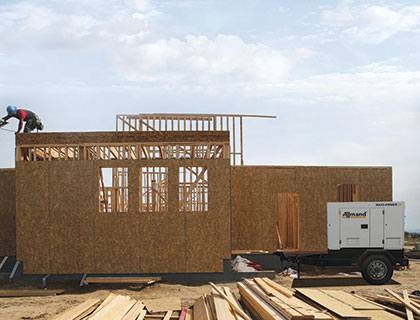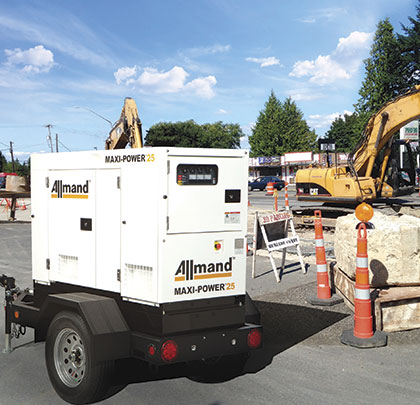Newton’s third law of motion tells us that for every action, there is an equal and opposite reaction. When it comes to selecting a generator, for every non-action, there is also a reaction—and typically, it’s not in the customer’s favor. Savvy contractors and rental center owners and managers understand that several factors need to be considered before investing in equipment. If anything is overlooked or omitted, projects run the risk of encountering delays and avoidable expenses that will ultimately cut into profits. While selecting a generator is not exactly advanced physics, the fact remains that variables—the jobsite, required capacity, generator features—need to be considered to make an informed and profitable decision.
PUT GOOD IN, GET GOOD OUT
In most cases, rental centers and equipment dealers can provide excellent guidance for customers looking to rent or buy a generator. Their suggestions, however, are only as useful as the information they’re provided. Only with a comprehensive understanding of the equipment a customer will be powering, along with any other job-specific factors, can they determine the ideal generator.
To develop a complete picture of what features and power range will be ideal for the job, there are a number of things to consider up front. Some jobs require a generator that’s capable of handling significant surge loads without flinching. For others, the ability to switch frequency or run on an external fuel supply can provide valuable jobsite flexibility. The most important factor to consider, and the most common mistake that individuals make, is selecting a unit that doesn’t match the power required for the job.

Featured Image: To increase the time between fuel refills, Allmand generators are capable of switching from the on-board fuel source to an external one, drastically extending runtime.
Above: An ideal generator should have enough power to run everything at a site, but not so much that it will be running significantly below its rated load capacity.
BIGGER IS (NOT) ALWAYS BETTER
When making a purchase, choosing an option that exceeds one’s expected need is often a sound and logical choice. When purchasing a computer, for example, it may be difficult to determine exactly how much storage will be needed. Even if a 500 GB hard drive seems sufficient at the time of the purchase, uncertainty about future storage needs can make it easy to justify spending more up front for a computer with additional storage. When choosing a generator, however, having more power than necessary is actually a detriment.
While the problem with a generator that’s too small is obvious—not having adequate power to run the necessary tools—an oversized generator can limit productivity nearly as much. Ideally, a generator should have enough power to run everything at a site, but not so much that it will be running significantly below its rated load capacity. When diesel generators operate below 50-60 percent capacity, they run the risk of wet stacking.
Wet stacking occurs when a diesel engine does not run hot enough to completely burn all of its fuel, resulting in carbon buildup in the exhaust. This can happen when the engine idles or, in the case of a generator, runs too long with an insufficient load. Although wet stacking is not a new problem, Tier 4 regulations have forced manufacturers to improve the output-to-emissions ratio. As a result, engines are more prone to wet stacking and thus more likely to require regeneration, a process that can take the generator out of service for as long as 30-45 minutes. Shutting down for regeneration even once during the day results in wasted time and lost revenue.
In some cases, contractors may opt for two smaller generators, as opposed to a single larger unit, to avoid wet stacking. This provides workers the option of shutting down one unit to adjust for demand. Although this may increase initial costs, it can deliver savings for some jobs by reducing downtime and improving application flexibility. If purchasing, contractors receive the added benefit of being able to split the two generators between jobs in the future.
GREAT CAPACITY, GREAT PRODUCTIVITY
For jobs requiring a generator to run around the clock, an undersized fuel tank will not only limit productivity but also become a nuisance. To provide more time between fills, many generators are equipped with large fuel tanks and boast runtimes exceeding 24 hours. To further increase the time between refills, look for generators capable of switching from the on-board fuel source to an external one. Drawing from an external source can drastically extend runtime compared to units that are limited to an onboard fuel supply. While this option is available from many manufacturers, some have made it standard, while others do not offer it at all.
With or without an external fuel supply, if levels are not monitored properly, the generator may run dry. When this happens, most generators require a trained technician to prime the system to get it operational again. For rental customers, this means guaranteed downtime while waiting on a service call. Some manufacturers have eliminated the need for that call by adding an automatic fuel priming system. This system allows the operator to simply turn the key back to start and the system will prime itself. Although no one plans to run a generator completely out of fuel, it does happen, and having a self-priming generator can cut downtime significantly and curtail lost revenue.
CHOOSE WISELY
From geography and equipment specs to power output and safety, consider all of the variables at play when selecting the ideal generator. Sir Isaac Newton may not have had standby power in mind when he formulated the third law of motion, but he definitely understood cause and effect. Investing time upfront to understand which elements will help maximize ROI leads to a profitable decision and overall success.
Check out this article on the web (www.mcsmag.com) with additional content featuring doing more with less, maintaining success, and location as a factor.
About the Author:
Brian Northway is a product manager with Allmand Bros. Inc., a subsidiary of Briggs & Stratton Corporation. It offers an extensive line of rugged, portable, high-performance products for the construction, mining, rental, and oil and gas industries. Its product lineup includes towable light towers, mobile generators, portable air compressors, mobile industrial heaters, portable light stands, and solar flashing arrow boards. For more information, visit www.allmand.com.
_________________________________________________________________________
Modern Contractor Solutions, January 2018
Did you enjoy this article?
Subscribe to the FREE Digital Edition of Modern Contractor Solutions magazine.



